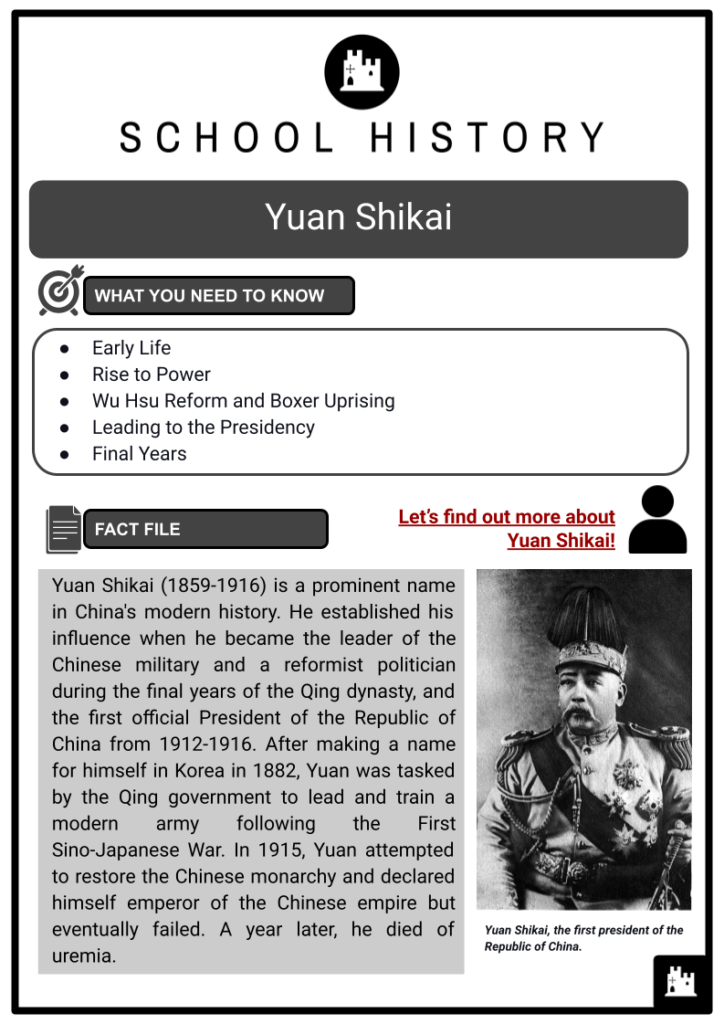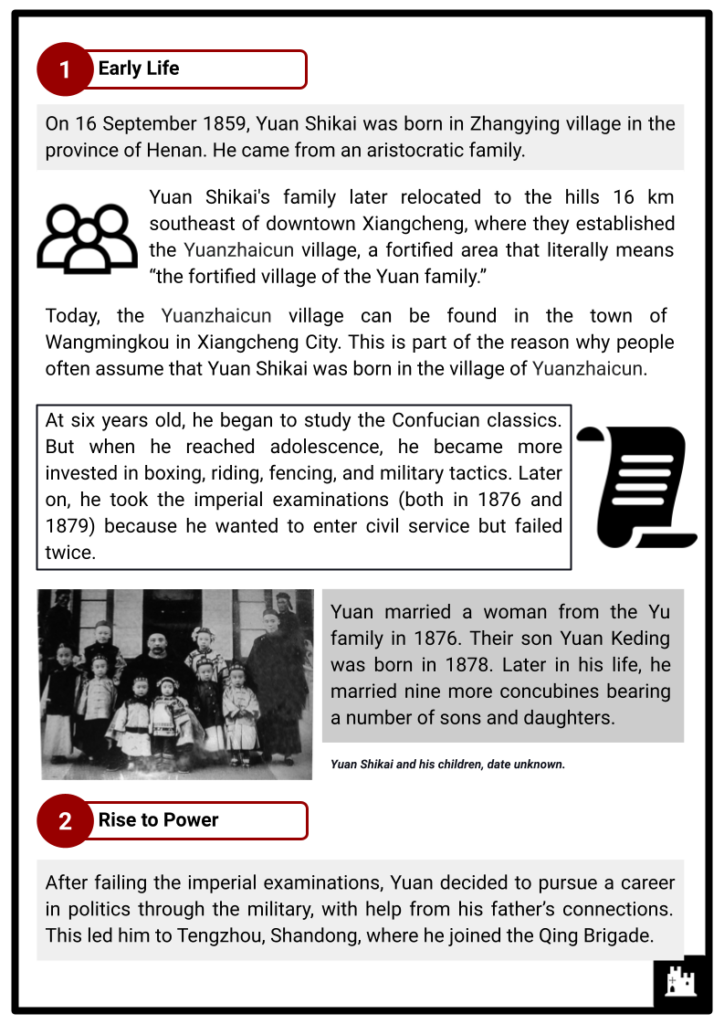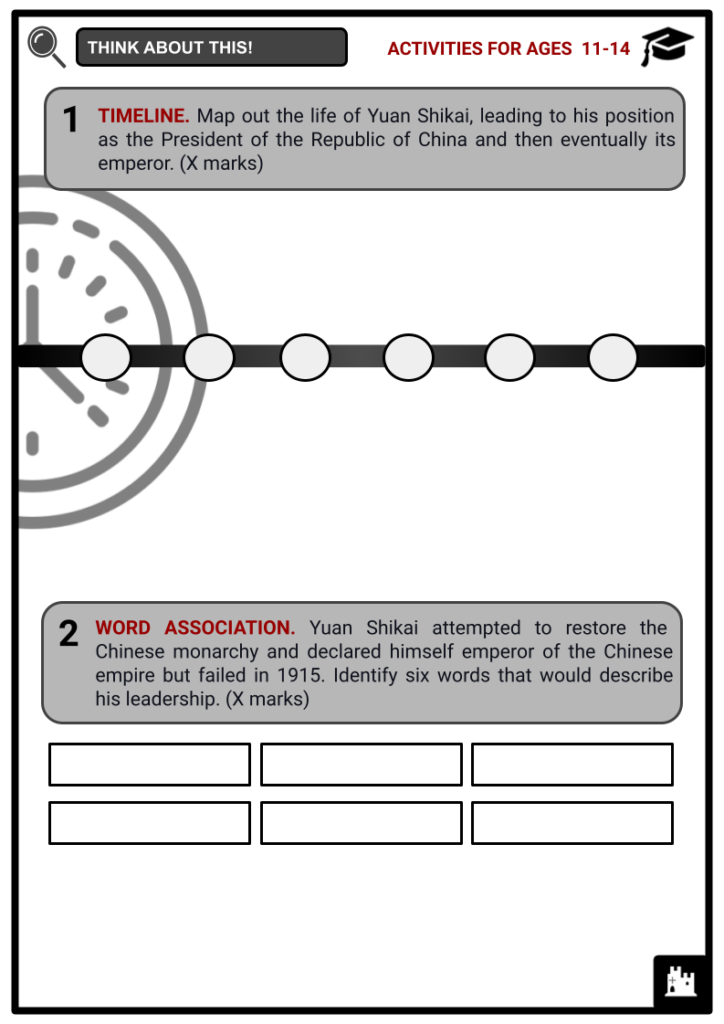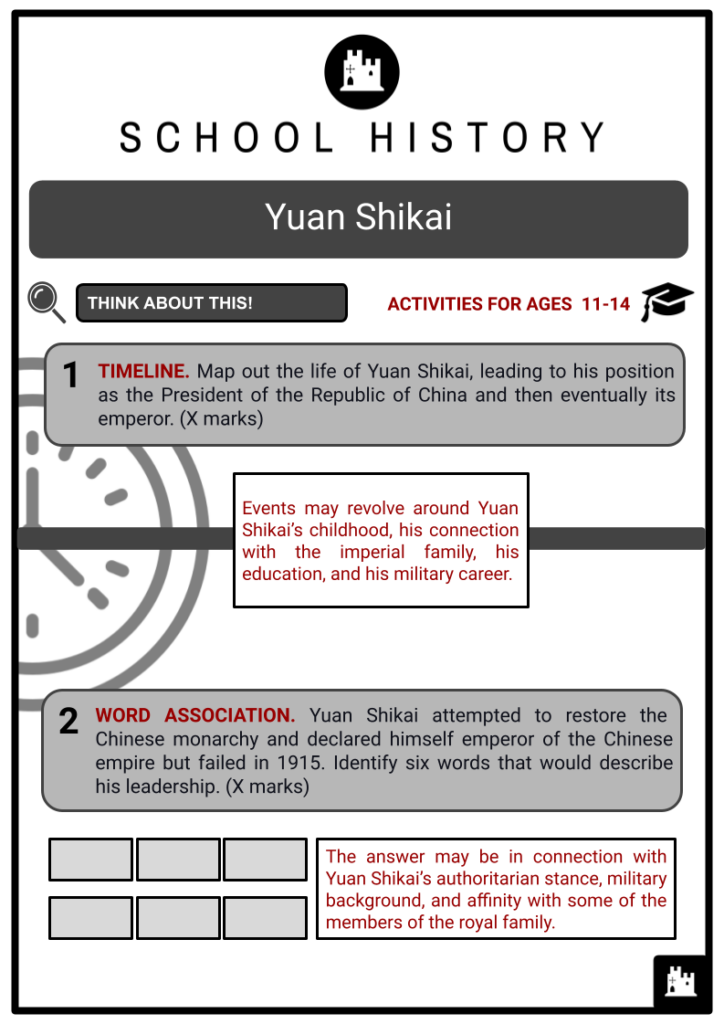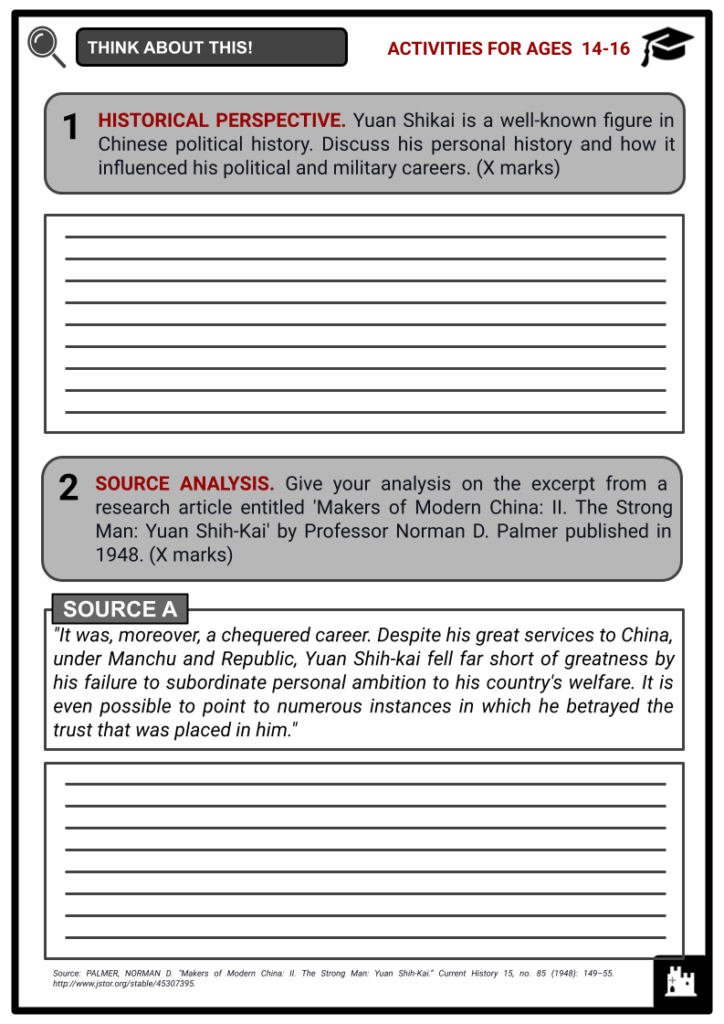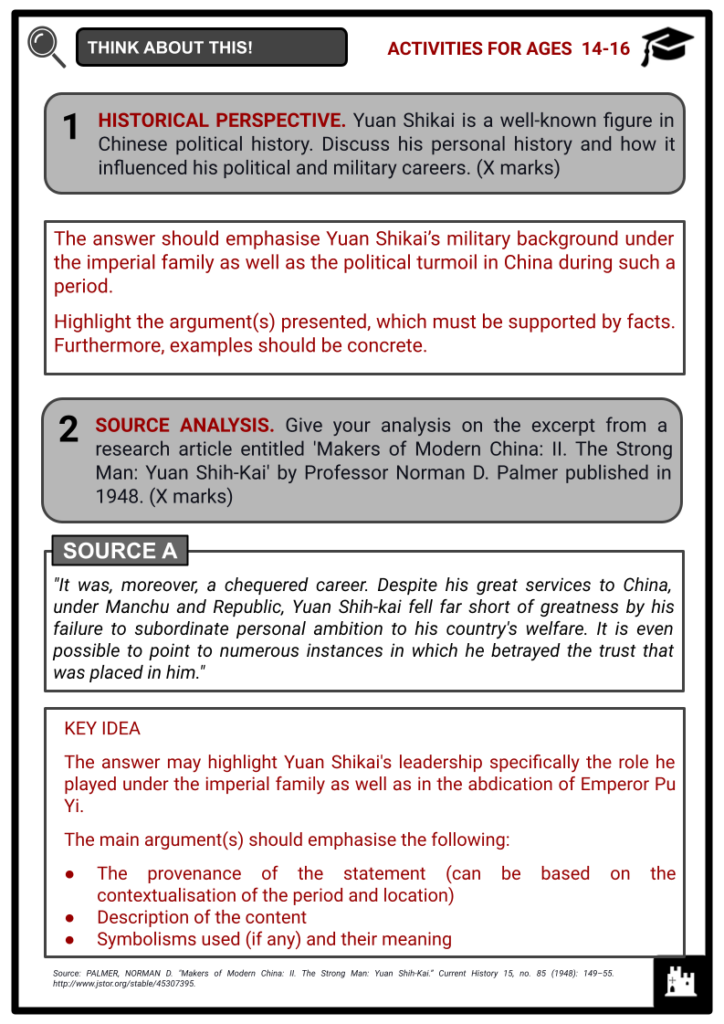Yuan Shikai Worksheets
Do you want to save dozens of hours in time? Get your evenings and weekends back? Be able to teach about Yuan Shikai to your students?
Our worksheet bundle includes a fact file and printable worksheets and student activities. Perfect for both the classroom and homeschooling!
Summary
- Early Life
- Rise to Power
- Wu Hsu Reform and Boxer Uprising
- Leading to the Presidency
- Final Years
Key Facts And Information
Let’s find out more about Yuan Shikai!
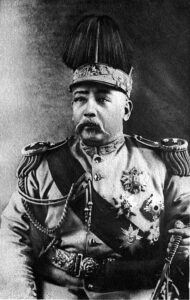
Yuan Shikai (1859-1916) is a prominent name in China's modern history. He established his influence when he became the leader of the Chinese military and a reformist politician during the final years of the Qing dynasty, and the first official President of the Republic of China from 1912-1916. After making a name for himself in Korea in 1882, Yuan was tasked by the Qing government to lead and train a modern army following the First Sino-Japanese War. In 1915, Yuan attempted to restore the Chinese monarchy and declared himself emperor of the Chinese empire but eventually failed. A year later, he died of uremia.
Early Life
On 16 September 1859, Yuan Shikai was born in Zhangying village in the province of Henan. He came from an aristocratic family.
- Yuan Shikai's family later relocated to the hills 16 km southeast of downtown Xiangcheng, where they established the Yuanzhaicun village, a fortified area that literally means “the fortified village of the Yuan family.” Today, the Yuanzhaicun village can be found in the town of Wangmingkou in Xiangcheng City. This is part of the reason why people often assume that Yuan Shikai was born in the village of Yuanzhaicun.
- At six years old, he began to study the Confucian classics. But when he reached adolescence, he became more invested in boxing, riding, fencing, and military tactics. Later on, he took the imperial examinations (both in 1876 and 1879) because he wanted to enter civil service but failed twice.
- Yuan married a woman from the Yu family in 1876. Their son Yuan Keding was born in 1878. Later in his life, he married nine more concubines bearing a number of sons and daughters.
Rise to Power
- After failing the imperial examinations, Yuan decided to pursue a career in politics through the military, with help from his father’s connections. This led him to Tengzhou, Shandong, where he joined the Qing Brigade.
- Greatly encouraged by the period of Westernisation, a movement that aimed to gain military knowledge from Western countries, Yuan swore allegiance to the commander of the Huai army, Wu Changqing. Yuan became the commander’s assistant in May 1881.
- Yuan’s first notable military engagement was when he was assigned to quell the rebellion in Joseon dynasty-era Korea. At the time, the father of the Gaozong Emperor of Korea, Heungseon Dawongun, attempted to claim the throne via a military coup, resulting in a power struggle between him and Empress Myeongseong.
- Myeongseong sought the help of the Qing government to send military forces to suppress the coup. Sent by Li Hongzhang, the viceroy of Zhili (now known as Hebei Province), Yuan led the troops and emerged victorious.
- After Heungseon Dawongun was imprisoned at Baoding (located in Hebei Province), Li Hongzhang named Yuan as the supreme adviser on Korea’s government policies.
- At age 23, Yuan managed and trained the Korean army, controlled Korean taxes, and gained the approval of the Korean nobility. When Japanese forces tried to abduct Korean and Gaozong Emperor Li Xi in another military coup in 1884, Yuan led the Huai army and aided the Koreans against the Japanese.
- Since the Qing government had vested interests in Korea at the time, Yuan’s victory meant further influence and approval from Li Hongzhang.
- In 1894, during the Dongxuedang uprising in Korea, the Korean emperor again sought help from the Qing government as per Yuan’s advice. Following this, the Japanese government brought more forces to Korea in an attempt to begin a war. However, prior to the start of the First Sino-Japanese War, Yuan came back to China after masquerading as a peasant while travelling through Inchon.
- Yuan would later be appointed by Li Hongzhang to lead the training of the new Chinese army, which began in Tianjin in 1895. Under the leadership of Li Hongzhang, Yuan also managed the training and expansion of the Dingwu army, which later became known as the Beiyang army, the late Qing dynasty’s (1644-1912) primary land force.
- From 1911 to 1949, at the time when the Republic of China was established, warlords (e.g., Xu Shichang, Duan Qirui, Feng Guozhang, Wang Shizhen, Caokun, and Zhang Xun) were often trained under the Beiyang army.
- By 1897, Yuan was already serving as the Zhili (Hebei Province) high court’s chief prosecutor. A year later, he held a higher position as the President of the Board of Industry.
Wu Hsu Reform and Boxer Uprising
- During the Wu Hsu Reform of 1898, Yuan was advised by Tan Sitong – the leader of the said reformist movement – to lay siege to the Summer Palace, where the Empress Dowager was staying.
- Yuan refused the advice and informed a pro-empress official, Rong Lu, of Tan’s plot. As a result, the Guangxu Emperor was imprisoned, hence the failure of the Wu Hsu Reform.
- Following the failure of the Wu Hsu Reform, Yuan became the Shandong Province governor. He later brought his new army into Jinan to quell the Boxer Rebellion, an anti-colonial and anti-foreign uprising in China between 1899-1901. Because of Yuan’s strict policies, the Boxers were forced to flee to Tianjin and Beijing.
- By 1900, when Britain, France, Russia, the US, Germany, Italy, Japan, and Austria (also known as the Eight Power Allied Forces) attacked Beijing, only the province of Shandong remained standing under the command of Yuan. In 1901, following the Boxer Protocol agreement, the Guangxu Emperor introduced new policies, which Yuan highly promoted. It was the time when Shandong University was established.
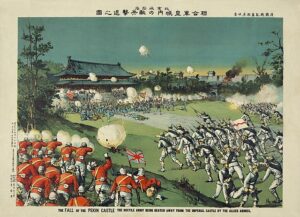
An image depicting the Boxer Rebellion, an anti-colonial uprising in China that took place in 1899-1901. - In 1903, the Army Drilling Ground was established in Beijing. Yuan then led the Beiyang army’s drilling. Moreover, Yuan engaged in the construction of industrial and mining establishments in China, alongside railways, the police force, and new-style universities. The military strategist also abolished the imperial examination.
- After the successive deaths of the Guangxu Emperor and Empress Dowager in November 1908, the young Prince Pu Yi, who would later become the Qing dynasty’s last emperor, succeeded to the throne. The prince’s father, Zai Feng, served as regent and fired Yuan from his post due to Yuan’s part in the failure of the Wu Hsu Reform. Yuan was forced to move to Anyang in the province of Henan.
Leading to the Presidency
- On 10 October 1911, the Wuchang Uprising occurred, an armed rebellion in Wuchang against the ruling Qing dynasty. It marked the start of the Xinhai Revolution, which successfully deposed China's last imperial dynasty. During its outbreak under the command of Li Yuanhong, the northern provinces’ warlords and the Beiyang army remained neutral.
- On 1 November 1911, Yuan, after earning support from different parties, was appointed as chancellor (prime minister) by the Guangxu Emperor. By 13 November, Yuan came to Beijing and established his cabinet three days after.
- Surprisingly, Yuan changed tactics to prevent further unrest. He negotiated with the revolutionaries, particularly with Li Yuanhong, and came to an agreement to hold a national assembly on 18 December 1911, in which they would elect a new president.
- On 29 December 1911, Sun Yat-sen was elected as the first provisional President of the Republic of China by representatives from 17 southern Chinese provinces. Sun took oath on 1 January 1912, marking the Republic of China’s establishment. Refusing to accept the result, Yuan led his army to seize Wuhan and Nanjing, hence the power struggle with the revolutionaries.
- Sun Yat-sen’s United League could not match Yuan’s military force. Sun later talked to Yuan and promised him the presidency if Emperor Pu Yi would renounce the throne.
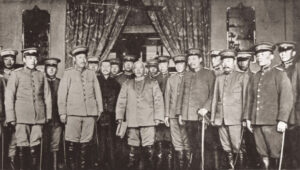
Yuan Shikai was sworn in as Provisional President of the Republic of China in March 1912 in Beijing. - On 12 February 1912, Pu Yi was forced by Yuan to step down from the throne, despite the resistance from Empress Yulong. This marked the end of the Qing dynasty. Three days later, the Nanjing councillors formally voted Yuan as the provisional President of the Republic of China. However, Yuan’s power was tempered by the Republic of China’s parliamentary government system.
- By May 1914, Yuan would succeed in overhauling the provisional constitution, resulting in the establishment of a presidential government system. Unfortunately for Yuan, it was also the year when the First World War broke out.
- Japanese forces besieged Jiaozhou Bay and the Jiao-Jinan Railway in Shandong Province, which was occupied by the Germans. The Yuan government could not do anything to prevent the attack.
- Consequently, Japan introduced the “Twenty-One Demands” to the Yuan, which included the expansion of Japan’s rights and privileges in Manchuria and Mongolia, as well as the appointment of Japanese officials to the Republic of China’s council. The negotiations between the two parties lasted from 2 February to 2 May 1915. Yuan eventually accepted the terms of the Japanese on 8 May 1915.
Final Years
- On 20 November 1915, Yuan held a special representative meeting, aiming at electing himself as the emperor of China. By the next month, Yuan gained enough support from the Congress, university students, and mass groups to push for the revival of the constitutional monarchy and the Empire of China.
- On 12 December 1915, Yuan took his oath as emperor. Shortly after, Yuan changed the name of the Presidential Palace to Xinhua (New China) Palace. He also introduced new royal policies, such as the abolishment of the eunuch system, the tribute system, and the maids-in-waiting selection system. However, the warlords from the provinces of southern China resisted Yuan’s tough policies, resulting in successive uprisings.
- On 25 December 1915, Yuan’s influence was further weakened by the opposition of General Cai E and General Tang Jiyao, which was soon followed by the generals from the provinces of Guizhou and Guangxi.
- In March 1916, Yuan had no choice but to disestablish the new empire. State Secretary Duan Qirui was then tasked to quell the insurrection taking place in southern China. Two months later, Yuan’s health condition worsened, and he eventually died of uremia on 6 June 1916. He was 57 years old. On 24 August 1912, Yuan was buried in Anyang in the province of Henan.
Image Sources
- https://upload.wikimedia.org/wikipedia/commons/thumb/a/aa/Yuan_shikai.jpg/640px-Yuan_shikai.jpg
- https://upload.wikimedia.org/wikipedia/commons/thumb/9/9e/Beijing_Castle_Boxer_Rebellion_1900_FINAL.jpg/640px-Beijing_Castle_Boxer_Rebellion_1900_FINAL.jpg
- https://commons.wikimedia.org/wiki/File:Yuan_Shikai_sworn_in_as_Provisional_President_-_10_March_1912.jpg

